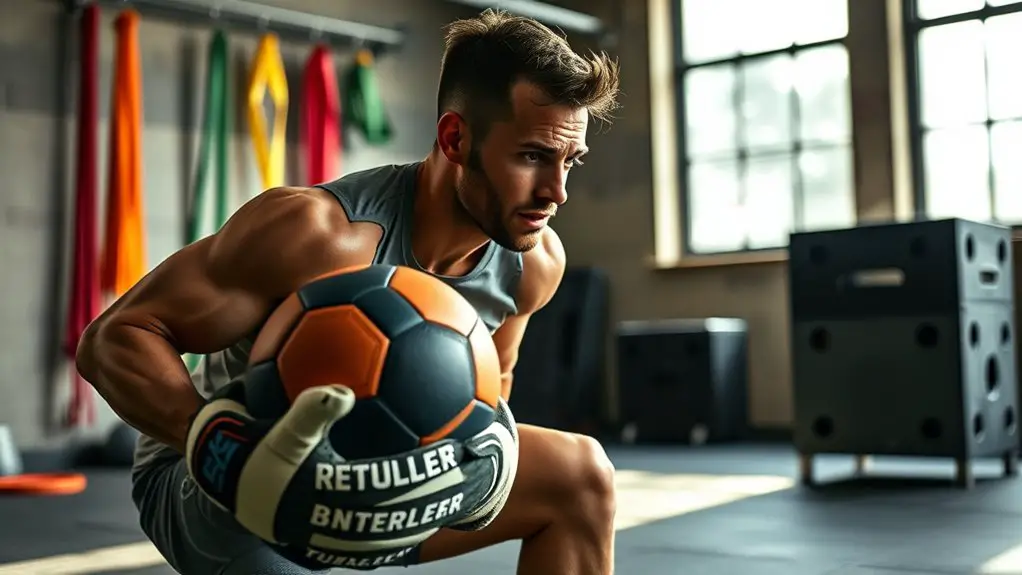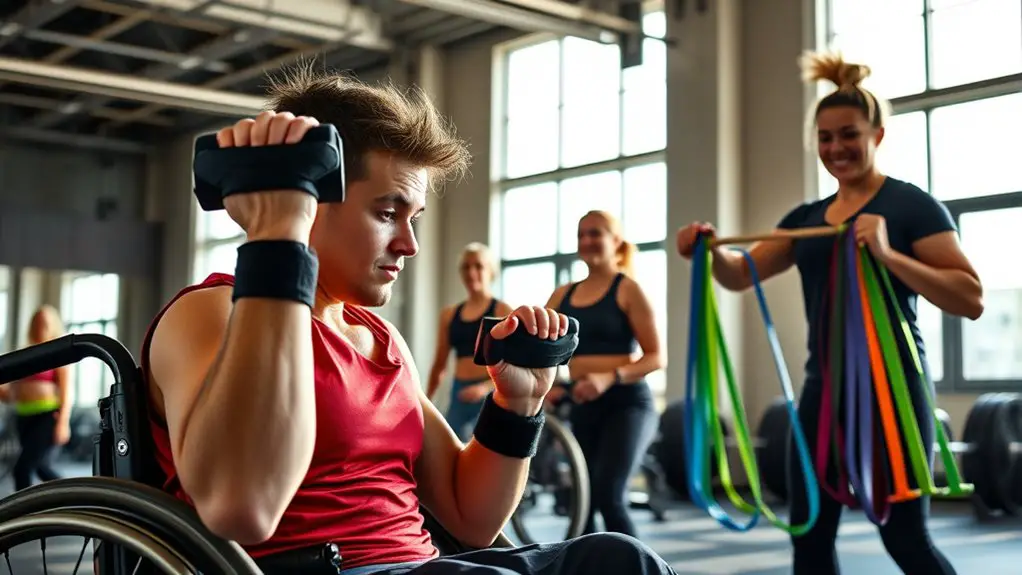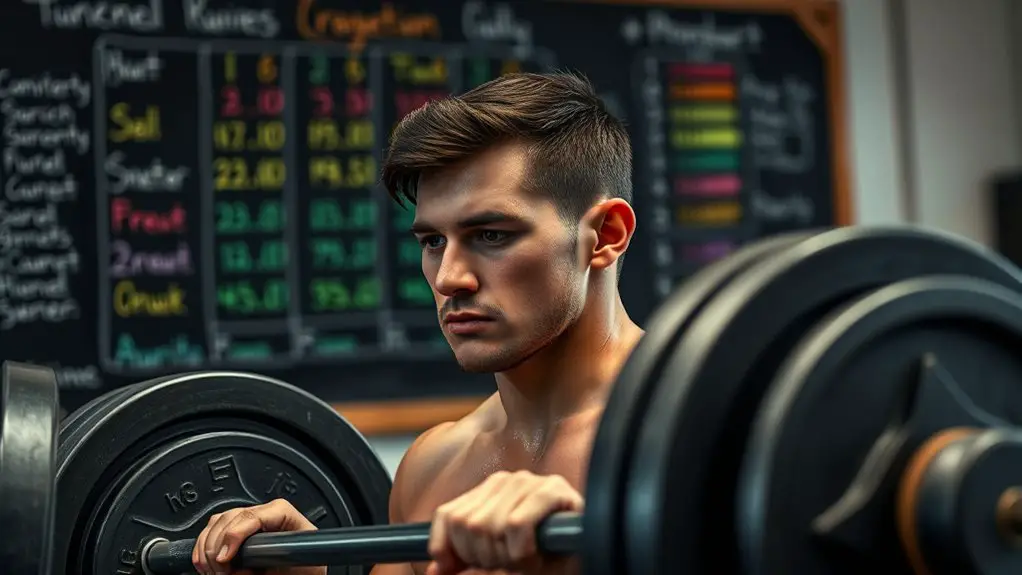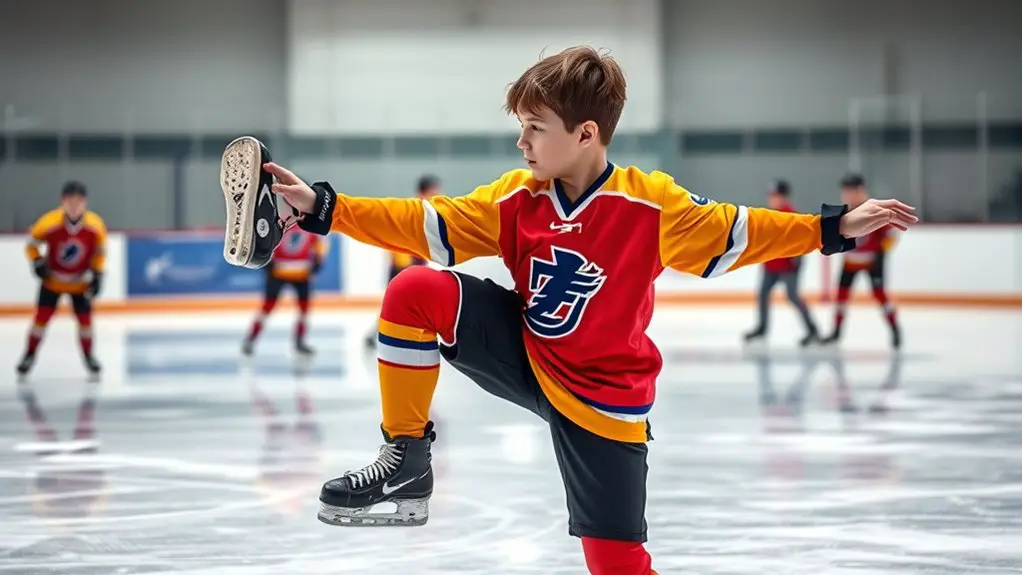Strength training for goalkeepers is essential for boosting performance. Focus on building core strength with exercises like planks and Russian twists. Enhance your agility and quickness through footwork drills, like ladder and cone drills. Incorporate explosive power exercises like box jumps and depth jumps to elevate your strength. Don't forget to improve your reaction times with partner drills and visual cues. By mastering these key exercises, you'll unleash your full potential on the field. Discover even more tips ahead!
Building Core Strength for Goalkeepers
Building core strength is essential for goalkeepers, as it serves as the foundation for stability and agility on the field. When you focus on core stability, you're not just enhancing your physical presence; you're releasing the freedom to move fluidly without hesitation. Incorporating balance training into your routine can amplify these benefits. Simple exercises like planks, Russian twists, and stability ball workouts can help you develop a powerful core.
As you engage in these activities, you'll find that your body becomes more responsive, allowing you to dive, jump, and pivot with ease. Remember, a strong core supports not just your movements but also your confidence in goal. Embrace the journey of strengthening your core, and you'll discover how it transforms your performance. You'll feel more agile, balanced, and ready to face challenges head-on, giving you the freedom to express your skills on the field. Additionally, core strength is crucial for connecting the upper and lower body for efficient movement, enhancing your overall athletic performance.
Enhancing Agility and Quickness
While strength is crucial, enhancing agility and quickness is equally important for goalkeepers, as these skills determine your ability to respond to fast-paced gameplay. Incorporating footwork drills into your training routine can greatly improve your lateral movement, allowing you to cover the goal more effectively. Consistency in practice is essential for optimal results, as it leads to significant improvements in athletic performance.
Here's a quick overview of essential agility drills:
| Drill | Focus Area |
|---|---|
| Ladder Drills | Footwork precision |
| Cone Drills | Lateral speed |
| Shuttle Runs | Quick directional changes |
Developing Explosive Power
Developing explosive power is crucial for goalkeepers, as it directly impacts your ability to make quick, powerful movements when it counts the most. To enhance this critical skill, incorporate plyometric drills into your training routine. Exercises like box jumps and depth jumps can greatly boost your vertical leap and lateral quickness, allowing you to cover more ground in the goal.
Additionally, powerlifting techniques, such as the clean and jerk, can build overall strength and explosiveness. These movements engage multiple muscle groups, promoting effective force generation. Incorporating proper technique into your training maximizes explosive power and reduces injury risk.
Don't forget to focus on your core, as a strong core translates to better stability and power transfer during sudden movements. Remember, it's all about combining strength with speed. Embrace these training methods, and you'll find yourself reacting faster and jumping higher when the game is on the line, giving you the freedom to perform at your best.
Improving Reaction Times
To excel as a goalkeeper, improving your reaction times is essential, as it can mean the difference between a game-winning save and a missed opportunity. You can enhance your reflexes through targeted practice and drills that challenge your instincts. Here are some key strategies:
Improving reaction times is crucial for goalkeepers; targeted drills can transform missed opportunities into game-winning saves.
- Use Reaction Drills: Engage in drills that require quick decision-making and movement.
- Focus on Visual Cues: Train your eyes to pick up on the ball's trajectory and players' movements.
- Incorporate Partner Exercises: Work with a teammate to simulate game scenarios, which sharpens your responsiveness.
- Utilize Technology: Employ tools like reaction lights or apps that test your speed and coordination. Additionally, practicing mental conditioning techniques can significantly boost your ability to respond quickly under pressure.
Boosting Overall Athleticism
Boosting your overall athleticism is essential for a goalkeeper, as it enhances not just your performance but also your endurance and agility on the field. To achieve this, mix endurance training with flexibility exercises in your routine. Endurance training, like interval running or circuit workouts, will help you maintain high energy levels throughout the match, allowing you to sprint and dive without fatigue. Incorporating flexibility exercises, such as dynamic stretches or yoga, not only improves your range of motion but also reduces injury risk. This combination keeps you light on your feet, making it easier to react to shots and movements. Additionally, consistent mileage builds aerobic capacity, which is critical for sustaining energy during matches.
Frequently Asked Questions
How Often Should Goalkeepers Incorporate Strength Training Into Their Routine?
Did you know that athletes who incorporate strength training into their routines see a 20% increase in performance? For goalkeepers, it's vital to maintain a conditioning schedule that includes strength training at least two to three times a week. This frequency not only enhances your agility and power but also helps prevent injuries, allowing you the freedom to express your skills on the pitch without worrying about your physical limitations.
What Equipment Is Essential for Goalkeeper Strength Training?
When you're diving into goalkeeper strength training, having the right equipment can make all the difference. Essential gear includes resistance bands, dumbbells, and a stability ball for various drills. You'll also want access to a weighted vest or ankle weights to enhance your goalkeeper drills. This equipment helps you build power, stability, and agility, giving you the freedom to move confidently on the field. Embrace the challenge and elevate your game!
Can Strength Training Prevent Injuries in Goalkeepers?
Absolutely, strength training can play a vital role in injury prevention for goalkeepers. By focusing on muscle conditioning, you're not just building strength; you're enhancing your body's ability to handle the demands of the game. Strong muscles and ligaments support your joints, reducing the risk of injuries during intense matches. So, if you're looking to stay agile and free on the field, incorporating strength training into your routine is a smart move.
Should Goalkeepers Focus More on Upper or Lower Body Strength?
When it comes to the age-old question of upper versus lower body strength, you've gotta strike a balance. While strong legs help you dive and sprint, upper body strength's essential for powerful throws and maintaining stability. Think of it like a well-oiled machine—every part matters. So, focus on both! You'll not only enhance your performance but also enjoy the freedom to move fluidly and confidently on the field.
How Can Goalkeepers Balance Strength Training With Skill Development?
Balancing strength training with skill development is essential for you. You can integrate both by creating a flexible training schedule that allows for skill integration. For instance, alternate days between strength sessions and skill-focused practices, or combine them in one session by incorporating strength exercises that mimic goalkeeping movements. This way, you're not just building muscle but also enhancing your technique, ensuring you develop holistically without feeling restricted in your training approach.




